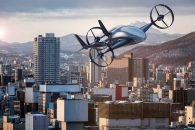As a United States Marine veteran, I’m routinely fascinated with the innovation of military technology. As a professional in the aviation insurance industry, when that military technology involves the future of helo drones and electric aircraft, I become obsessed. It’s always been true that warfare has been one of the largest driving forces in technology and innovation. After all, war is notoriously unkind to the 2nd place finisher. Thankfully for the world, that technology can often be adapted for peaceful purposes. The atomic bomb was designed to bring about at swift end to World War 2 and now, nuclear technology provides power to large swaths of the United States. So it is with drones and unmanned aircraft. Let’s take a few minutes and see what the defense industry is bringing us today.
Unmanned and Artificial Intelligence in the Skies
The Israeli firm Steadicopter has recently created a couple of new models of its rotary unmanned aerial vehicles. Essentially, they are an adaptation of the Black Eagle 50 platform that fly with quieter engines and are intended for use in covert or maritime operations. Now, because Steadicopter does not name customers, we don’t fully know who has these drones already in operation. However, we can assume that every major power has something similar in place, if not a more advanced version of what the Israeli company disclosed.
It is sort of a general rule of thumb that major powers like the United States are a few steps ahead of military technology from whatever is disclosed publicly. However, unless you plan to kick off your own covert ops, you may be wondering what the impact on the civilian drone market may be.
The Black Eagle 50 has a range of 150 kilometers and a flight time of 4 hours. The Black Eagle 50E can reach heights of 10,000 feet. Those same performance measures that were intended for military purposes will now allow civilians to reach more distant locations for peaceful purposes. Think evaluating remote pipelines or perhaps even making a small delivery to an offshore oil rig. It sometimes takes the civilian market a little more time to appropriate the technology, but I routinely look at the emergence of military technology as the future of what is eventually coming down the pipeline. Remember, the internet was originally built for defense purposes and now that same technology has you reading this wonderful blog on helo drone and electric aircraft insurance!
What’s the Impact on Drone Insurance/Electric Aircraft Insurance
As it pertains to your aviation insurance policies, if it flies in the skies above, then we generally can find coverage for it. Granted, we don’t find coverage for military aircraft as I’m sure the liability of a Predator Drone strike into a terrorist’s bedroom window would be high. However, once that technology rolls down to the civilian market and it is simply mapping or prospecting a remote part of the American wilderness, we got it covered.
Here at BWI Aviation Insurance, we are a family and veteran owned operation that has been sourcing insurance for over 40 years. From one generation of BWI to the next, we’ve seen this technology advance at a rapid pace and we couldn’t have envisioned some of the aviation operations that would be covering into the future.
BWI | The Future Of Aviation Insurance
Family Owned Since 1977 | Nationwide | Forward Thinking
What makes us different? Our office is open 12 hours a day, our team is hand-picked, well-trained and every single customer has their own dedicated Aviation Insurance Professional.
Get a no-obligation, customized Drone Insurance or Electric Insurance Quote at www.bwifly.com or call 800.666.4359
Continue Reading



